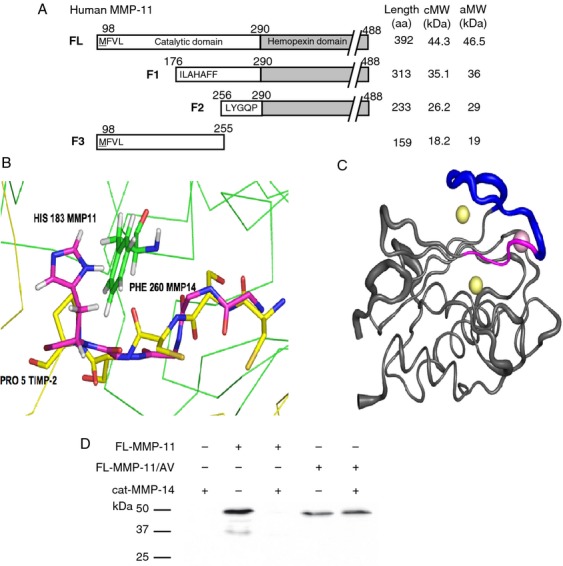Figure 5.

Identification of cleavage sites and molecular modeling of MMP-11/MMP-14 interaction. (A) F1 to F3 N-ter amino acid sequences established using Edman analysis. aa, number of residues; cMW and aMW, calculated and apparent fragment molecular weight (coomassie blue or silver nitrate), respectively. (B) 3D structures of MMP-11 (PDB ID: 1HV5) 33 and MMP-14 (PDB ID: 1BQQ) 32. All calculations were done using the CHARMM program with the all-atom 27 protein force field 47. Initial hydrogen positions were calculated using the HBUILD facility 48. Synthetic and protein ligands were removed, as well as crystallographic water molecules. Cartoon showing the PGG(P1)-I(P1′)LA cleavage site (situated in N-ter of strand IV 33) inside the MMP-14 active site compared with the TIMP2/MMP-14 complex. TIMP-2 is represented as a yellow Calpha trace, excepted for the sequence CSCSP (all atoms shown) and MMP-14 as a green Calpha trace, excepted the Phe260 (all atoms shown). TIMP-2 residues CSCSP placed in the active site of MMP-14 superpose to MMP-11 residues GILAH (179–183); only the backbone atoms are shown (carbon in pink), excepted the His183 (side chain shown). MMP-11 His 183 (superposed to TIMP-2 Pro 5) is naturally close to Phe 260 of MMP-14 with which it could form aromatic stacking. (C) Root Mean Square fluctuations of MMP-11, obtained from normal mode analysis using the VIBRAN module of the CHARMM program 49 are depicted on the MMP-11 backbone. Increased width of the cartoon representation indicates regions of higher flexibility, in particular, the long S-shaped loop, situated N-ter to the cleavable site, even while coordinating the structural zinc and calcium ions. MMP-11 GILAH (179–183) in pink; S-shaped loop (165–178) in deep blue; zinc and calcium ions, yellow and pink spheres, respectively. (D) Cat-MMP-14 does not cleave recombinant FL-MMP11/AV (GI to AV mutant). Western blot analysis using 5ST4C10 monoclonal antibody recognizing MMP-11 showed that FL-MMP-11/AV was no more digested by Cat-MMP-14. Data from one representative experiment. MMP-14, matrix metalloproteinase-14.
